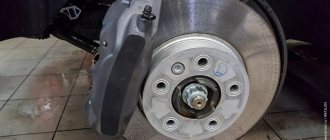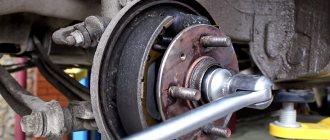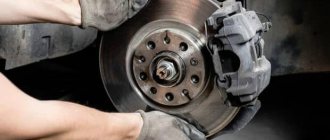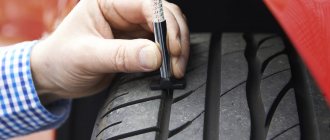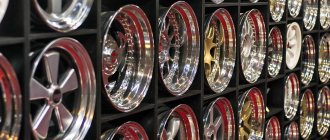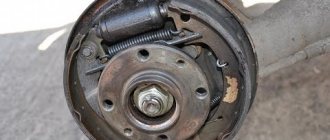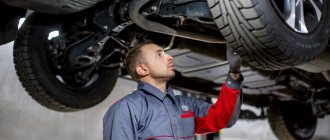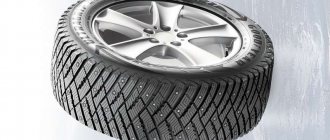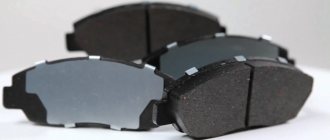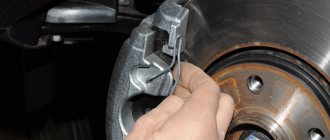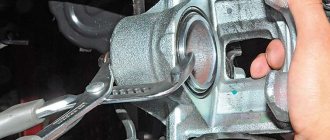The brake disc is no less important in the braking system of a car than the pads. And if the latter are replaced when worn out, then almost no attention is paid to the former. But the efficiency of the system also depends on them. Let's find out how to determine the wear of brake discs so that they can be replaced on time.
Most of the discs that lie on the shelves of car dealerships are made of cast iron. The popularity of such products lies in their low cost and good friction characteristics. But the problem is that in the process of reducing the speed, the cast iron alloy product heats up. This leads to deformation, warping, and uneven abrasion. To reduce wear and tear from heat, manufacturers began to produce products with ventilation. Grooves are also cut on the surface of the disk. This allows you to increase the life of the disk.
What affects wear?
Each manufacturer prescribes brake disc wear standards. These parameters are obtained based on engine power, vehicle weight and other factors. But it is very difficult to calculate the mileage after which you will need to change the discs. Wear is influenced by various factors that cannot be taken into account.
First of all, it's your driving style. If the car owner prefers to drive more extreme, where sharp accelerations are replaced by equally sharp braking, then the service life of the disc is significantly reduced.
The conditions in which the vehicle is used also affect wear and tear. If you constantly move through puddles in winter, the moisture that gets onto the heated disk can cause deformation and uneven wear.
Mechanical factors also affect the service life. The material from which the brake disc is made is important here, as well as the quality of the pads. Often, discs are made from cast iron and its alloys - the material wears out more often than ceramics. The use of low-quality pads (for example, with asbestos) also leads to uneven wear.
Material of manufacture
Until relatively recently, cast iron was used as the main material for the production of brake discs. The quality characteristics were at a relatively high level and they could be used for quite a long time. However, cast iron weighs quite a lot and manufacturers needed to look for an alternative to reduce the load on the supports. Therefore, carbon compounds and ceramics are now used as the main materials, although their service life has been reduced. And if the manufacturer ignores some production standards, then such products can fail much earlier than indicated in the technical specifications.
Symptoms of wear
Many people do not know how to determine the wear of brake discs, but it is very simple. There are several signs that it is time to change the disk.
The first indicator is vibrations, grinding noises, and extraneous sounds during the process of reducing speed. The second symptom is the car skidding due to the brake system being blocked. After the driver presses the pedal, the brakes may jam.
If one or more of the signs listed above appears, then it is worth moving on to visual diagnostics. Carefully inspect the working surface of the disk. There should be no beads, cracks or other damage on it.
Drum brakes
Drum brakes are less efficient than disc brakes, but they are cheaper, have lower maintenance costs and have a longer service life without replacing consumables. On modern passenger cars, this type of brake is used exclusively on the rear axle.
Brake pad wear
During smooth braking, even worn-out drum brake pads may not show themselves, since they are less involved in the braking process. But when braking sharply, the car may begin to slow down unexpectedly weakly.
To determine the level of pad wear:
- Remove the wheel;
- Remove the brake drum;
- Measure the thickness of the brake pad.
The thickness of the pad must be at least half the thickness of the new pad. Replace if necessary.
How to find out the abrasion thickness?
In order to find out the permissible maximum thickness of the brake disc, you should look at the end of the product. There are two meanings to this part. This is the original thickness, as well as the minimum allowable. The numbers may vary depending on the car and wheel manufacturer. How to determine the degree of wear of brake discs? It is enough to simply measure with a caliper and compare the numbers with acceptable standards. This is how you determine whether the product can still be used or not. The disc should also be changed if it has different thicknesses at different points.
This indicates uneven wear.
Stages and features of diagnosis
The measuring stage of the test involves the use of a caliper, which will help make thickness measurements. At approximately 5-8 points, moving around the disk, measure the thickness. If it varies along the radius of the part, there are signs of curvature and uneven wear.
Check the information from the manufacturer to understand whether the wear limit has already reached or not. I cannot say which indicators are correct and which are not, since different discs have their own wear limits.
Then a visual inspection is carried out. The disc should be examined for cuts, chips, dents, scratches and other defects on its surfaces. If they are, the spare part will have to be replaced.
Do not forget about the rule of pairwise replacement on the same axis. That is, when the left front disc is changed, the front right one also changes at the same time.
If you want to assess the condition of the elements without removing the wheels, this can be done by checking while driving. With severe wear, characteristic signs appear:
- the car brakes jerkily;
- a grinding sound appears;
- there is a squeaking sound when you press the brake;
- other extraneous sounds are heard;
- the driver feels a beat on the steering wheel;
- the beating is also felt in the gas pedal;
- When the brake pedal is pressed, the braking system is locked.
I strongly do not recommend waiting for such symptoms to appear. It’s better to periodically do simple diagnostics in your garage through visual inspection and measurement. This is usually done every 10-15 thousand kilometers, if wear symptoms do not appear earlier.
..
Fix defects or replace?
When the measurements are completed and the exact diagnosis is clear, the car owner is faced with the question of whether to restore the old product or purchase a new one. It should be remembered that the disc can be sharpened only if there is residual thickness (from 22 millimeters). This is true for ventilated discs. Many experts recommend replacing only. However, if the price of a new disk is too high, and there is a spare thickness, you can try to restore it.
Small beads and grooves can be removed by grooving using special equipment. Some even do the grooving with a file, but this is unreliable. The essence of the operation is that a thin layer is removed from each side of the disc. Then the product receives a perfectly flat surface.
Do not forget that the more layers are removed during grinding, the shorter the service life of the restored brake disc will become. Sometimes you need to remove two or even three layers. It is not recommended to install used or refurbished drives. It is unknown where and how they were used. However, knowing how to determine the wear of brake discs, you can measure and find out whether they are acceptable for use.
Before boring the disc, the cause that caused the deformation or beads on the surface should be resolved. Otherwise there is no point in restoration. Among the causes of uneven wear, brake pads are in first place. If they are of poor quality or installed incorrectly, they can easily damage the surface of the disk.
Recommendations for selection
Rule one and very important: you cannot change the front or rear brake pads one by one. It is necessary to install a set of new elements on the front or rear axle, otherwise when braking the car may seriously drift to the side. Even when one pad is worn out, all four must be replaced . As a temporary option, it is possible to install 2 new parts on one rear wheel.
When choosing new pads in the store, use the following recommendations:
- Products must match the car model and be sold in high-quality packaging with included instructions. The inscriptions on the box are clear and without errors indicating Chinese origin.
- Make sure that the friction material is the same color, without foreign inclusions.
- The surface pressed against the plane of the disk must be flat. Small chips along the edges and depressions are allowed if they occupy no more than 1% of the total area of the working plane.
- Cracks at the interface between metal and friction material are unacceptable.
Ideally, you should buy original products in original packaging. This will save you from unpleasant surprises, unscheduled replacements and emergency situations when operating your car.
When to change pads?
We know how to determine the permissible wear of brake discs. But it’s worth paying attention to the pads, since these elements work in pairs and together affect braking efficiency.
One of the signs of pad wear is a squeaking sound when the speed is reduced. The sound is produced by a special wear sensor. This is a special plate. When the friction layer of the pad is worn away, the plate touches the disc and causes the sensor to operate.
If the car does not have a wear sensor, then the pads should be replaced when the thickness of the friction layer is one and a half millimeters.
You can determine that the pads are worn out by the operation of the brake system. Brakes that are too weak or too harsh can indicate wear. In the first case, the braking is not intense, although the pedal is pressed quite deeply. In the second, the wheels are blocked due to the lack of friction lining.
How to determine the wear of brake discs and pads? This can be determined by vibrations during braking, as well as by visual inspection and a measuring tool. There are no other options.
How to extend the life of disks?
Sudden temperature changes, extreme driving style, and overheating of cast iron discs are the main enemies of parts that lead to their rapid wear. You can extend the life of disks. Firstly, you should limit driving on mountain roads, and you should also stop braking sharply and start quickly.
Secondly, you need to periodically send your car for inspection. It is best if the technicians check the correct operation of the caliper pistons. You can carry out the procedure yourself. To do this, you need to jack up the car and rotate the wheel. “Heavy” rotation, creaking and grinding sounds indicate that the caliper is faulty.
The pads should be changed before the due date. When choosing products, the driver should buy only high-quality parts from well-known manufacturers.
And the last piece of advice is that the owner should “protect” heated discs and pads from contact with water. For example, there is no need to “drive” along the road in rainy or snowy weather. All brake system parts should also be allowed to cool before washing.
We determine the mileage based on the condition of the disks
Today, cars are sold by so-called resellers, who often deceive buyers. Cars come with low mileage. Many of them only look normal outwardly, but technically they are in a deplorable state. Resellers often change the pads, but simply forget about the discs. And this is in vain - the average mileage of a car can be determined by the condition of the disk.
On average, brake discs are changed every 180-200 thousand kilometers. But this is not true for all cars. Also, different drivers drive differently. Some people manage to drive 150 thousand kilometers until they are completely worn out, and some even 250. But if the mileage of a car is 70 thousand, and the total thickness of the disk is 20 millimeters, this car has probably traveled at least two hundred. It is worth refusing to purchase such a copy.
Here's how to determine mileage based on brake disc wear. But disks can be replaced more than once. And the mileage can be twisted. Therefore, the condition of the discs is just one of a number of signs that you need to pay attention to when purchasing.
Questions and answers
What is the service life of discs and pads?
There are a large number of factors that influence the service life of parts. Many manufacturers believe that the lifespan of pads is 30-120 thousand kilometers, and that of discs is 3-4 times longer. On domestic cars, parts must be replaced after 10 thousand km, and on foreign cars after 20 thousand km.
What is the cost of brake discs?
The average price of discs ranges from 3,000 to 5,000 rubles per unit. The highest quality parts with the best characteristics cost about 7,000 rubles or more.
Is it possible to drive with worn rims?
The rotors help the driver stop the car. If they do not work correctly or are worn out, it means that the car owner will not be able to brake, especially in the event of an emergency. This will lead to dire consequences. That is why, when problems are detected, it is better to eliminate them immediately, and not endanger pedestrians and other drivers.
Repair or complete replacement of brake discs is carried out if:
- Disc deformation occurs, which manifests itself in the form of vibration and ineffective braking;
- Deep edges and grooves form throughout the brake disc;
- The thickness of the disk reaches a critical level of 1-3 mm (the measurement is made with a caliper; it is the working area that is measured, and not the outer edge);
- There are other damages that prevent effective braking.
- Brake disc crack.
- "Bead" formation.
- Uneven wear, the appearance of grooves, holes and depressions on the surface of the disc.
How to choose a brake disc and not run into a fake?
Today, things have begun to be counterfeited to such an extent that it is practically not clear where the original part is and where the fake is, so remember one simple rule, spare parts should always be purchased in car stores (Not in some cooperatives where ordinary people trade, but specifically in a special auto store) and the larger it is, the better, even if you overpay a little in terms of money, you will still buy a good original item, because specialized auto stores generally do not sell counterfeit goods and be sure to check with the seller if there is guarantee for the purchased product, without a guarantee you even need to take it, in fact it’s just a recommendation to you from us, because as we said earlier, recently counterfeits have become so good that it’s no longer possible to tell where the original is where is the fake, well, make it a habit, never buy spare parts without boxes (They should all be packaged, and the box should contain a manufacturer’s certificate or something like that).
Minimum thickness
To be honest, this is a different indicator for all manufacturers, that is, there is no unified value when it is necessary to make a replacement. For example, for our VAZs this is one thing, but for my Chevrolet AVEO it is completely different. All these parameters depend on the structure of the calipers, pads and the disc itself.
For example, on some Nissan models, as well as Renault Logan, the standard thickness is 22 mm
The minimum recommended by the manufacturer is 20 mm.
For VAZ
The minimum for ventilated options is 17.8 mm
For non-ventilated ones - 10.8 mm.
It should be noted that the manufacturer usually indicates wear of 1 mm on the sides. Then you need to replace it! However, I know from practice that many tighten them to unacceptably thin sizes, sometimes wear of 3 or more millimeters on the sides is wrong.
What you should not do under any circumstances
It is clear that wheels are not cheap, the price can range from 1,500 to 10,000 rubles per piece, it all depends on the model and class of the car.
Some “homemade” ones solder (screw) additional linings onto the brake pads, thus giving them greater thickness. The caliper cylinder does not extend a long distance, pushing the pad, effectively as if restored! But guys, you shouldn't do this:
Firstly, there is no guarantee that this homemade cover will not come off.
Secondly, the disk is still thin, and therefore it can collapse at any moment. Watch this video here.
Remember the brakes, especially the front ones, are for your safety; you shouldn’t joke with them.
That's all, read our AUTOBLOG.
(
8 votes, average: 5.00 out of 5)
Similar news
Engine cylinder deactivation system. All the truth.
Check Engine. What does it mean and why does it light up?
Why does the turbine drive oil? To the intercooler (also to the intake manifold)
When the owner actively uses the car, especially in urban conditions, problems with the brakes may occur. There are situations when, in addition to changing the pads, you need to replace the brake discs.
Preparing to replace the AP
Having determined that the TD is faulty, you need to prepare to change them yourself. To do this, you first need to buy a new spare part from a car store.
When choosing brake discs for his car, the car owner must take into account his driving style. Does he like to accelerate sharply and actively maneuver? How often does he use the brakes? He drives a lot around the city or mostly intercity trips on the highway.
The spare part from which manufacturer you need to buy depends on these factors. Discs can be standard or sports.
- Standard TD - made of cast iron, the casting is processed on a milling machine. They are ventilated and non-ventilated. Without ventilation, it is a single disc that is pressed on both sides by brake pads. A disk with ventilation is easy to distinguish - it is two disks connected by bulkheads. Ventilation occurs during movement due to air entering between these pancakes. Some of the respected manufacturers of these products are Bosh, Zimmerman, ATE.
- Sports TD - made of durable and ultra-strong gray cast iron, as well as austenitic stainless steel. These are considered to be more durable products that can last much longer and with more aggressive driving. Such discs are produced by EBC, DBA, Brembo.
The driver must remember that when the front brake discs are replaced, they must be changed in pairs, even if one of them is suitable for further use in all respects. The same rule applies to rear brakes.
This rule is explained by the fact that unequal weight of the same type of spare part on the wheels of the same axle will lead to loss of directional stability.
Types of brake discs?
So, it's time for a replacement. What to choose from the variety presented?
First of all, you need to consider the design features: are there ventilation holes, is perforation provided, is the disk made of one metal or composed of different...
Today, almost all brake discs are ventilated and, unlike non-ventilated ones , they consist of two plates, the cavity between which provides additional cooling. Regardless of the number of plates, the disks may or may not be perforated. In this case, through and buried perforations are distinguished (not through). The first cools well and removes working gases, but can negatively affect the reliability of the disk. The second also effectively copes with the removal of burnout products and at the same time contributes to the preservation of strength properties.
Disks are also classified into solid (made from a single piece of metal) and composite : the aluminum hub and cast iron ring are bolted together, which prevents spontaneous unwinding. Composite discs have high thermal and ventilation characteristics (due to the use of aluminum alloy), resistance to deformation, lighter weight and the possibility of partial replacement (for example, only the rings).
